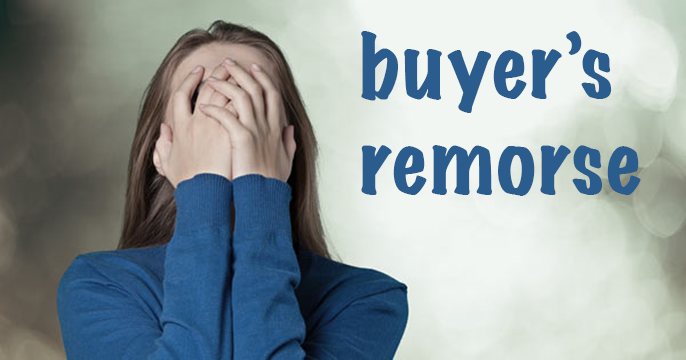Mitigating Buyer’s Remorse
by Sid Raisch
(You don’t have time to NOT read this right now because you have customers deciding whether you’re too expensive, or they spent too much in your store and if they’ll never be back.)
What is “buyer’s remorse”? In a word, buyer’s remorse is regret. There are two main sources of buyer’s remorse. One is a cognitive dissonance, where the investment in the purchase consumes the financial resource that could have alternatively been invested in something else of near equal desire. Another is a fear that the purchased item or service isn’t worth the amount it cost. There is some lag time between the customers decision to purchase and the questioning of that decision and in that gap of time is precisely where an appropriate and intelligent effort to counteract the emotion is necessary.
Plugging the Customer Leak
Building a business requires keeping customers coming back at a higher rate than you can replace them with new customers. Pre-Covid-19 the attrition rate was surprising for garden retailers who were able to measure it – in the 25% range. In the past two years, new customers have been coming at a much faster rate than attrition, but it was still happening. There are many reasons customers don’t come back, and some of those are beyond your control. What if you could stem the tide by mitigating buyer’s remorse?
To overcome buyer’s remorse we can help them overcome the fears they are feeling. (Incidentally, while helping customers overcome their fear you are overcoming your own fear that your customer will not come again.)
(This is a sequel to the articles on Mitigating Inflation (Click HERE), and Mitigating Sticker Shock. (Click HERE.)
There have always been signs of buyers remorse in garden centers, although you may not have known what they were. The return of a purchase can be due to buyer’s remorse, even though the customer does not admit it. The most common is the observation of the customer stopping in their tracks just past the checkout and staring at their receipt, comparing it to the items in their shopping cart before moving on?
Buyer’s Remorse is not to be avoided as the only way to do that is to sell at a lower price which is an easy way out, but lazy and more important than that, not profitable. The cost of replacing customers is high, and the cost of doing without them is higher yet. The work to overcome buyer’s remorse is the work of great retail. The answer to mitigating it is not to eliminate it, but to understand and accept it and then deal with it effectively to overcome long-term negative consequences on customers returning to your store.
There may have been a slight increase in buyer’s remorse in 2021, and there may be another increase in 2022 if we don’t implement some tactics to mitigate the effect of rising prices to create more buyer’s remorse.
Big Purchases vs. Small Purchases
Regret is proportionate. The trigger for buyer's remorse is the size of the purchase which will vary by customer. Most customers won’t give a second thought to small purchases but will feel very differently when parting with larger sums. For some customers, $50 will be a trigger while others become fearful at $100 and yet others at $1,000.
$100 seems like a reasonable place to begin paying real attention, depending on the cost of the response, which can be minimal passive action at that level and more engaging and at a higher cost for large purchases. It may be best though to not take a chance and engage every customer as if buyer’s remorse could be happening.
Mitigating Buyer’s Remorse
An active reinforcement of the customer’s purchase decision is the minimal response and is as simple as a sincere and well-worded compliment to every customer on their purchase decision both verbally and in writing. Larger purchases require a proportionately larger effort which can still be very simple and inexpensive, and effective.
I’m clarifying the reality of our risk of buyer’s remorse, not giving free solutions to the problem here today. There are relatively small and inexpensive gestures that will mitigate buyers remorse and keep your customers coming back. The most important investment begins immediately upon the close of the transaction, before the customer leaves the checkout, and then follows them home. You can figure that out, but if you need more encouragement and useful guidance in this (and you do) I can help. Send a text now while you’re thinking about it and I’ll get in touch. 937-302-0423.
Your friend,


Before procrastination or other busyness steals another year from you Text or Call 937-302-0423 or send an email to [email protected] .
Sid Raisch is an advocate for family business leading growth, change, and results throughout US horticulture. Redefining the business future for consumer horticulture by understanding how the end-to-end supply chain needs to be redirected is a skill Sid has honed into an art. He has understanding and insight through inquisitive observations and extensive experience and has served as a trusted advisor helping transform both national and local businesses into more profitable and sustainable businesses. Developing national and international educational programs that create change in culture, community and company provides Sid venues with a front row seat creating effective and innovative business models.
Sid is a Certified Value Builder System Advisor, and currently serves as Chief Strategist and the Swiss Army Knife of Consultants to The Garden Center Group clients. Contact Sid at [email protected] or call or text 937-302-0423.
REMEMBER: Your interaction (by phone and email) with Group Service Providers such as Sid Raisch, Tim Quebedeaux, Jean Seawright, John Kennedy, and of course Danny Summers are included in your retainer!


